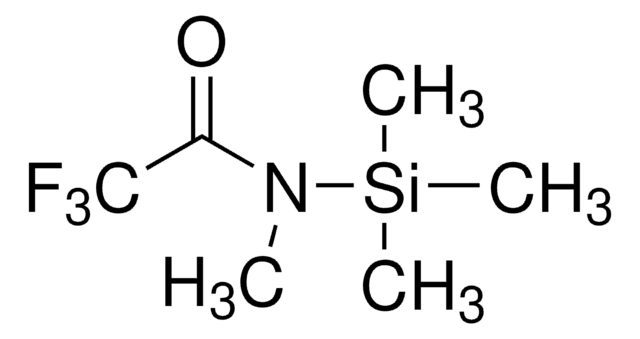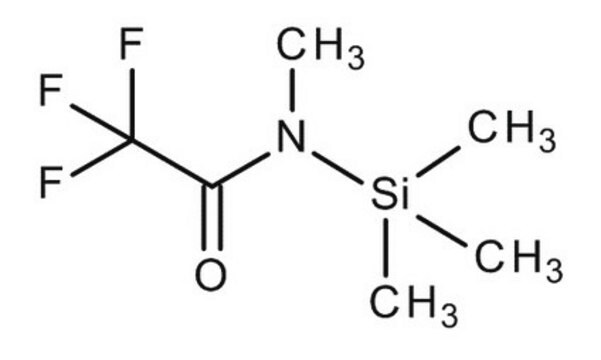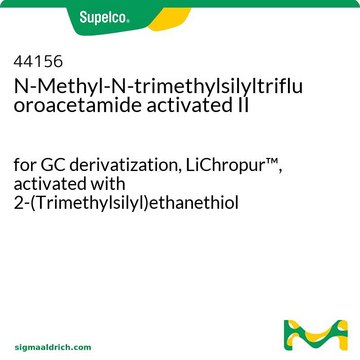M7891
N-Methyl-N-trimethylsilyltrifluoracetamid
BioReagent, for silylations, LiChropur™
Synonym(e):
N-Trimethylsilyl-N-methyltrifluoracetamid, MSTFA
About This Item
Empfohlene Produkte
Dampfdichte
>1 (vs air)
Dampfdruck
8.8 mmHg ( 27 °C)
Produktlinie
BioReagent
Form
liquid
Qualität
for silylations, LiChropur™
Eignung der Reaktion
reaction type: Silylations
reagent type: derivatization reagent
Methode(n)
gas chromatography (GC): suitable
Brechungsindex
n20/D 1.38 (lit.)
bp
130-132 °C (lit.)
Löslichkeit
chloroform: soluble 0.1 mg/mL
Dichte
1.07 g/mL at 25 °C (lit.)
1.075 g/mL at 25 °C (lit.)
Lagertemp.
2-8°C
SMILES String
CN(C(=O)C(F)(F)F)[Si](C)(C)C
InChI
1S/C6H12F3NOSi/c1-10(12(2,3)4)5(11)6(7,8)9/h1-4H3
InChIKey
MSPCIZMDDUQPGJ-UHFFFAOYSA-N
Suchen Sie nach ähnlichen Produkten? Aufrufen Leitfaden zum Produktvergleich
Allgemeine Beschreibung
Anwendung
- Bei der Derivatisierung der Metabolomik-Analyse mittels Gaschromatographie/Massenspektrometrie (GC/MS).
- Als Derivatisierungsreagenz bei der Gaschromatographie mit Flammenionisationsdetektions(GC-FID)-Analyse.
Verpackung
Rechtliche Hinweise
Ähnliches Produkt
Signalwort
Warning
H-Sätze
Gefahreneinstufungen
Eye Irrit. 2 - Flam. Liq. 3 - Skin Irrit. 2 - STOT SE 3
Zielorgane
Respiratory system
Lagerklassenschlüssel
3 - Flammable liquids
WGK
WGK 3
Flammpunkt (°F)
77.0 °F - closed cup
Flammpunkt (°C)
25 °C - closed cup
Persönliche Schutzausrüstung
Eyeshields, Faceshields, Gloves, type ABEK (EN14387) respirator filter
Analysenzertifikate (COA)
Suchen Sie nach Analysenzertifikate (COA), indem Sie die Lot-/Chargennummer des Produkts eingeben. Lot- und Chargennummern sind auf dem Produktetikett hinter den Wörtern ‘Lot’ oder ‘Batch’ (Lot oder Charge) zu finden.
Besitzen Sie dieses Produkt bereits?
In der Dokumentenbibliothek finden Sie die Dokumentation zu den Produkten, die Sie kürzlich erworben haben.
Kunden haben sich ebenfalls angesehen
Unser Team von Wissenschaftlern verfügt über Erfahrung in allen Forschungsbereichen einschließlich Life Science, Materialwissenschaften, chemischer Synthese, Chromatographie, Analytik und vielen mehr..
Setzen Sie sich mit dem technischen Dienst in Verbindung.










